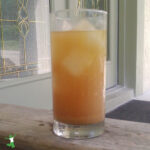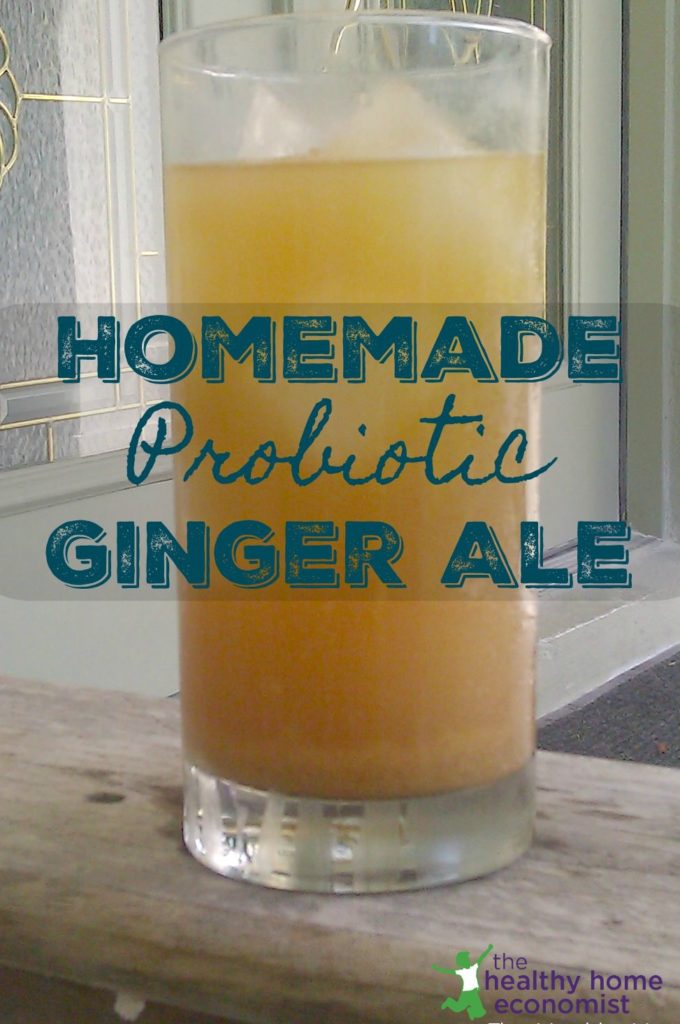Table of Contents[Hide][Show]
A traditional recipe for homemade ginger ale that is lightly fermented with cultured starter, which adds beneficial probiotics and enzymes for digestive benefits as well as delicious taste!

Ginger ale is one of the easiest drinks to whip up at home in a matter of minutes.
The bonus of making ginger ale yourself is that you can ferment it.
This means it is loaded with beneficial bacteria known as probiotics. In addition, traditionally brewed ginger ale is rich in enzymes and has enhanced nutritional value.
Fermentation of grains, fruits and herbs into refreshing and delicious drinks is nearly universal in ethnic cuisines, according to the Nourishing Traditions cookbook, from which this beverage recipe is adapted.
Sadly, the emphasis on convenience in our modern society means that this practice is largely forgotten with the continued popularity of commercial sodas.
Modern versions of ancestral beverages offer no redeeming nutritional benefit.
Worse, the consumption of these sugar-laced or artificially sweetened drinks encourages obesity and other chronic ailments.
Soda really can be healthy! Learning traditional preparation techniques is all that is required.
Preparation Tips
Raw liquid whey is the suggested starter for this beverage and the one I’ve used for decades with great success.
Please refer to this article on the various methods for making raw whey at home for additional details to determine which approach works best for you.
Note that you cannot buy raw whey commercially, although some small dairy farms have it available for purchase.
If a dairy allergy is present, a quarter cup of ginger ale starter or “ginger bug” or water kefir is a simple substitution.
Other ideas for dairy-free fermentation are detailed in the linked article.
While sucanat (pure dried cane juice) is the recommended sweetener, jaggery is a healthy option as well that produces great results.
Raw honey also works for those on gut healing diets such as GAPS. Note that the fermentation will generally occur a bit more quickly using it. I suggest reducing the fermentation time to 1-2 days if using raw honey.
A secondary fermentation using bottles to add additional fizz is optional, but a great idea if you have the time and inclination!

Homemade Ginger Ale Recipe
A traditional recipe for homemade ginger ale that is lightly fermented with cultured starter which adds beneficial probiotics and enzymes to the brew.
Ingredients
- 2 quarts filtered water
- 1/2 cup lime juice freshly squeezed, about 3 limes (preferably organic)
- 2 tsp ground ginger or 2 Tbsp freshly chopped ginger
- 1/3 cup sucanat
- 1 tsp sea salt
- 1/4 cup liquid whey do not use powdered whey
- 1-2 Tbsp raw honey optional
- pinch green stevia powder optional
Instructions
-
Mix all ingredients together thoroughly in a half gallon glass jar. Be sure to leave 1 inch at the top else the soda will get moldy instead of ferment. Affix a secure lid.
-
Leave at room temperature on the counter to culture for 2-3 days and then refrigerate. Homemade ginger ale is mildly fizzy. You can then mix with sparkling mineral water post-fermentation to add even more fizz if desired.
-
Alternatively, you can bottle the homemade soda and leave on the counter for an additional 1-2 days before refrigerating to produce a very fizzy beverage. Be sure to let the bottled soda get very cold before opening. Opening in the sink is a good idea.
-
If the finished homemade ginger ale is not sweet enough for your taste (usually necessary for those coming off a soda habit), add a pinch of optional stevia or stir in a small amount of raw honey.

Other Fermented Beverages to Try!








I ended up utilizing some powdered probiotic (acidophilus) that I mixed it with some
water.
hi can i use whey from homemade yogurt?
Yes you can!
Do you distinguish between ginger ale and ginger beer? Sally has a complicated recipe for ginger beer that is very good but that I’ve only had hit or miss success with. This recipe is much easier.
Yes, ginger beer is a different recipe.
I dont know if this comment will be seen since the original post was so long ago, but here goes! I followed the recipe above with only two exceptions: I used coconut sugar and the lid of the pitcher I used is not air tight. I let it sit on the counter for ~66 hours, stirring once since it looked like everything had settled to the bottom. At the end of this time, there was still a layer of ingredients just sitting on the bottom of the pitcher and minimal fizz. I had to go to work for a 24 hour shift, so I stirred again and divided into four small bottles, hoping for fizziness. Will see what it looks like when I get home, but was wondering if that sounds right??
Okay so I have made a couple of batches now and I like using fresh grated ginger, the taste is better. And you definitely cover it with the Mason jar lid. When you open the jar to stir the ingredients occasionally, it releases some of the gas so you don’t have an explosion.
Do you keep this covered? There is a lot of gas being released as it carbonates, don’t want it blowing its top.
Can coconut sugar be used instead of sucanat?
Probably but I’ve never tried it to know for sure.
Do you cap or cover the 2 quart jar during the first fermentation period?
We love ginger ale mixed with fermented lemonade!!! Sometimes we add raspberries!!!!
When you make the mixture and set it on the counter, do you cover it? What do you cover it with? The lid of the jar or cheese cloth?
I was wondering the same thing!